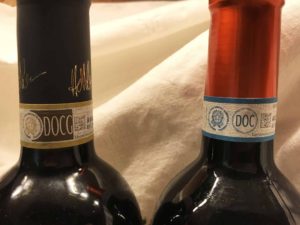Today I’m sitting in an interesting and eclectic coffee shop contemplating my blog post for this week and hoping that the inspiration will come to me. I notice a picture on the wall. To be fair, there are lots and lots of paintings and photographs on the walls that might inspire a blog post. But this one caught my eye…a photograph of an Italian wine bottle and corks. It got me thinking…maybe Italian wine classifications would make a good post on my blog. They can be confusing to some wine enthusiasts so I’m here for you. I’ll break them down so you’ll be more familiar and can make some good decisions when purchasing Italian wines.
In the Italian wine world, there are 3 “quality” classifications: PDO (DOCG & DOC), IGT, and VdT.

Let’s start with the top of the heap:
PDO (Protected Designation of Origin)
There are two classifications within the category, DOCG and DOC:
- DOCG is the highest and strictest level. It stands for Denominazione di Origine Controllata e Garantita.
Wines with a DOCG designation must follow the highest-level quality controls by the government. All wines must go through analysis and testing by a government approval panel. There are strict standards regarding where the grapes are grown, and the type of grape varieties used. This classification must be included on the wine label on the neck of the bottle. So, if you’re looking to venture into some of the highest quality Italian wines, look for the DOCG designation on the bottle.
- DOC is the next highest level and less strict. It stands for Denominazione di Origine Controllata.
This classification is included on most of the better-quality Italian wine bottles. The DOC wine also must follow strict governmental quality standards. They need to pass the same approval panel and testing as DOCG. They typically have more leeway as far as where the grapes are grown. They also must have the classification included on the neck of the bottle. Don’t discount this classification just because they don’t have a “G”. These are high quality wines that are delicious!
IGT (Indicazione Geografica Tipica)
This level of classification is used for Italian wines that didn’t meet the regulatory criteria for DOCG and DOC wines. Super Tuscan wines are an example of this classification. These wines are usually created in a non-traditional style. These include some of the winemaking methods and grape varieties that are not included in the usual government approval standards. This classification is represented by a wide variety of quality and price.
VdT (Vino da Tavola)
This is your typical Italian table wine. It is produced with very few rules or restrictions and is created to be an everyday drinking wine. There is a lot of experimentation going on…different grape varieties, blending methods, and winemaking experiments. Laws in Italy forbid VdT winemakers from putting a vintage on the bottles. If you want to experiment for yourself and see what a VdT wine is like, grab one at the local wine store and give it a try. It may be interesting, or it may be a reason for you to look for a wine within the other classifications to satisfy your Italian wine craving.

Hopefully this has been a helpful guide to choosing Italian wine. I personally look for the DOCG or DOC classification when choosing a nice bottle of Italian wine. You can get some really nice bottles for not a lot of money. The quality is backed up by the Italian government wine panel and they have given their stamp of approval for the DOCG & DOC classifications. What more can you ask for?
Cin cin!

